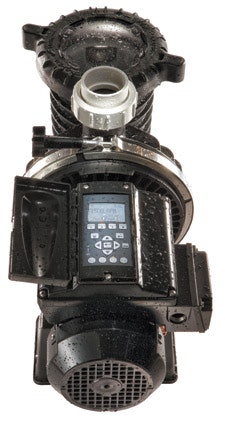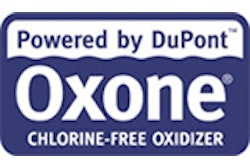
Something similar can be said of today's pool pumps. They have a lot of the same things going for them, while the newest variable-speed technology ushers in a new era. It follows that a typical pool pump service call is, as the saying goes, not what it used to be.
When many of today's pool industry veterans were newbies in the pool service business, a typical pump repair involved replacing motor bearings, capacitors or switches. Cleaning out the pump basket on older pumps meant undoing stubborn knobs or clamps. Service techs carried specialty tools, some homemade, and rusty set screws and bolts would break on the job.
And then there were those lovely bronze pump lids, which would warp if they were clamped on too tightly. But today's twist-lock lids not only seal more reliably, they are generally transparent. Being able to see into the baskets without having to remove the lids may seem like a simple thing, but it has made a big difference, says Ray Hoisington from Dal Pino Pools in Sacramento, Calif. He also doesn't miss modifying wrenches so they would fit inside a pump, and Hoisington appreciates newer materials that withstand chlorine and other salts better.
Thanks to plastic, which weighs less and nearly eliminates corrosion issues, along with easy-off lids, larger baskets that can go longer between cleanings, galvanized steel, Viton seals, and, more recently, a new breed of motors and new applications of variable-speed drives, the nature of pool pump repair has changed dramatically.
In addition to changes in materials and technology, another explanation for this shift is a change in consumer attitude. "In today's world, people are more likely to replace things than repair them," notes Sue Robach, currently the national training manager for Pentair Water Pool and Spa. But 20 years ago, when Robach ran a pool service business, bearing jobs were standard fare. And many bearing jobs were successful. They rendered the pump functional and satisfied pool owners for at least another season or two, often longer.
But today's consumer is more likely to opt for replacing a faulty motor or other piece of equipment if doing so extends their warranty coverage or otherwise increases the return on their investment.
Factor in the possibility of upgrading to a fancy new pump that, in some markets, will pay for itself in energy savings within a year or two, and it's easy to see why pump service today is very different from a generation ago.
Upstanding Service
In Southern California, where utility rates are high and pools are often used year-round, Wayne Nichol, owner of Blue Coast Pool Service in Oceanside, has mastered the art of selling his customers what they need. He paints an investment-oriented picture when he meets customers who can benefit from an upgrade to a variable-speed pump. "Where else can you put down $1,500 and get it back in two years?" he says, adding that the ROI is then compounded in subsequent years. "Can you do that with stocks or bonds?" he asks rhetorically.
As an example, Nichol recently replaced a capacitor on a 1.5-hp pump. It was a warranty job, so the pool owner was spared the expense. However, while on the job, Nichol's customer bragged about the $50,000 investment he had just made installing photovoltaic panels on his roof, so he could save money with solar energy. Nichol saw an opportunity.
"I told him that if he wanted to drop another $1,500, I could help him save even more," Nichol recalls. Nichol used a watt meter to demonstrate that the customer's pump was drawing 2,170 watts. Next, Nichol took the customer to visit a nearby pool that belonged to another of his customers. It had a variable-speed pump running at about 1,700 rpms. Not only did the watt meter show a dramatic difference in the power draw (400 watts compared with 2,170), but the variable-speed model, an IntelliFlo by Pentair, was barely audible. "He and his wife were sold on the quietness," Nichol recalls.
Farther north, Ray Hoisington also has an easy time explaining the advantages of a pump upgrade. "I tell people running their pool pump is like using 20 100-watt light bulbs for an hour, while a new pump would be like using four or five bulbs." Plus, Hoisington adds, when water moves slower, a pool gets cleaner because filtration cycles are longer and filters just work better. And he has personal experience to cite. Hoisington went from spending $120 per month on electricity to $80 or $90 when he upgraded to a variable-speed pump. (Rates in his area, near Sacramento, are between 10 and 12 cents per kWh.)
Another reason that many service techs sing the praises of variable-speed pumps is that they can be a one-size-fits-all solution. "Back in the day, if you had to replace an impeller, you would have to make sure the horsepower of the impeller matched the pump," recalls Robach. "That meant carrying lots of impellers on your trucks, or going back to the distributor for the right size." A well-equipped service truck might have had multiple pump wet-end rebuild kits for all the common sizes, which was a lot of inventory. That becomes far less necessary when one pump can be adjusted for a wide range of applications, as well-made variable-speed models can.
The Song Goes On
Another radical difference in some of today's pool pumps that changes how they're serviced is the motors used. Traditional induction motors have vent holes, where water can get in, making them susceptible to damage from sprinkler systems, ocean spray, excessive fog and other weather extremes. The totally enclosed fan-cooled motors used on IntelliFlo and IntelliPro pumps by Pentair, as well as the new Jandy FloPro from Zodiac, keep dust, dirt and moisture out, which is one of the reasons they last longer than traditional pool pump motors. This means a few things for service pros. First, the motors themselves should be far less susceptible to failure. Second, if there is a problem, the solution is more likely to be replacing the whole pump.
Another reason that variable-speed pumps last longer is that running on very low speeds improves the longevity of all the components. Low speed places less strain on the system, so bearings don't wear out like they used to, and heat doesn't build up causing premature motor failure or shaft seal leaks.
The science behind why slower speed and lower flow are worth the upgrade to a more expensive pump are easy to demonstrate if customers have water features. It is well-known that a ½-hp pump will overpump a laminar. One work-around for this situation over the years has been to plumb a bypass off the pump back to the pool, so only as much water as needed would go to the laminar. That is a waste of energy, Robach explains, noting that a well-designed variable-speed pump can be dialed down to generate only as much flow — and use only as much energy — as needed.
Another common work-around for water features has been to install ball valves that restrict flow to water features. This method leads to built up backpressure, and the pump still draws far more energy than required for the application.
Similar logic applies to the historic problem of overpowering copper plumbing. While pools today are plumbed almost entirely with PVC and have been for many years, there are still older pools in the field with copper lines underground. Water flowing at speeds generated by anything more than ½ hp has been known to erode copper pipe. Slowing the flow through that older copper pipe by using very low flow or speed settings on a variable speed (or variable flow) pump reduces the erosion potential inside copper pipes.
Going on a pump repair call armed with this information can lead to long-term solutions that benefit your customers, and your bottom line, in ways that yesteryear's bearing jobs did not.
Of course, it is still true that pumps can dry start, and repeated dry starts will lead to excess heat that can eventually damage the shaft seal or cause the PVC plumbing or pump parts to warp. Warped plumbing or pump parts in turn caused leaks. So not every pump service call is best met with a pump upgrade. Sometimes a simple repair will meet the need.
However, keep in mind that if the pump is also an SVRS (safety vacuum release system) being used to satisfy a safety code or other local regulation, replacing a part in the field may void the warranty or render the pump non-compliant with a safety regulation. Some regulations require verification (i.e., paperwork and possibly testing) when repairs on SVRS devices are completed in the field. Be sure you know the rules in your area if you are working on a pump with a built-in SVRS.
Another detail that was not in the pump service training manual decades ago is the greater importance of shutting power to the pump at the breaker before doing any work on it. Some of today's pumps have on-board automation controls that can override their "service mode" setting, causing the pump to resume operation when you are not expecting it.
In some ways, pump service has evolved along a similar trajectory as automobiles. Twenty years ago, an auto mechanic would pop the hood and know exactly what to do. Now, there are computer chips inside car engines, and troubleshooting is done online or by plugging the car into a device that generates digital diagnostics.
Today's pumps are pretty smart, but the know-how of a well informed service technician remains invaluable.
Comments or thoughts on this article? Please e-mail [email protected].











































